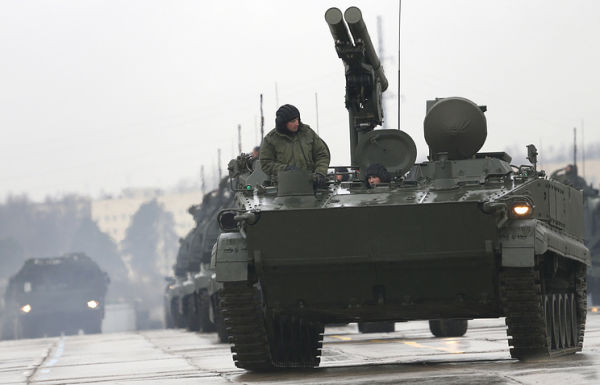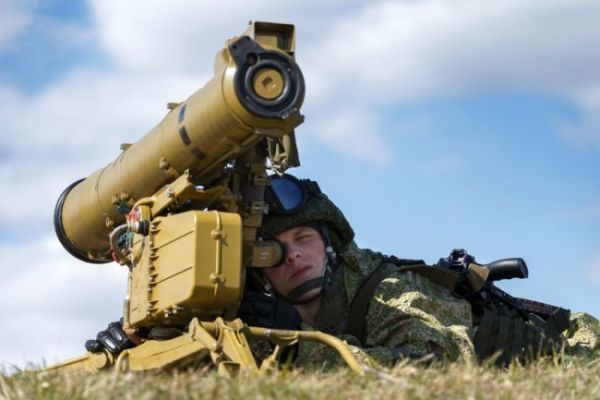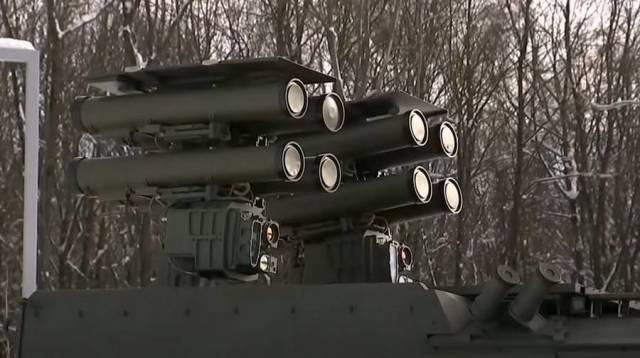This summer, the Tula Instrument Engineering Design Bureau (KBP, part of Rostec's High-Precision Complexes holding) delivered Kornet anti-tank missile systems (ATGMs) to the troops ahead of schedule. ATGM is one of the most effective types of weapons used by the Russian army in a special operation. They can hit armored vehicles, engineering structures and even drones. About which anti—tank missile systems are used in the SVO and what is the secret of their effectiveness - in the material of TASS
"Cornet"
In the footage published in the official Telegram channel of the Russian Defense Ministry at the end of July, a mobile group of Novorossiysk paratroopers destroys the enemy in the Kherson and Zaporozhye directions. The battle takes place in the area of the Antonovsky Bridge, from where, according to intelligence, a group of Ukrainian military corrects artillery. To destroy the enemy, a Russian amphibious buggy with an anti-tank missile system "Kornet" on board is being pushed across the bridge. A few seconds to aim, and now the Cornet rocket is flying through the Dnieper, and soon the abandoned house in which the spotters took refuge is shattered into splinters.
According to military expert, captain of the first rank of the reserve Vasily Dandykin, the use of the "Cornet" paired with a small vehicle has become a kind of know-how of Russian paratroopers. "Paratroopers are smart people, they put two ATGMs on an ATV, two people manage all this. They instantly turn around, strike and instantly disappear," the expert said in an interview with TASS.
ATGM "Kornet" is not the first time proving its effectiveness in its own. One of the most successful developments of the domestic defense industry will be used by the Russian military from the very beginning of the special operation. As previously reported by TASS, the complex is capable of firing simultaneously at two targets or firing two missiles at once.
"Cornet" differs in that it can work as a doublet. To bypass intelligent protection systems, two missiles are launched at once, which go to the target with a short interval. The first ammunition is used to penetrate the means of active protection, the second directly penetrates the armor and destroys the car. And all this is possible at a distance of 3-4 km," says Vasily Dandykin.
The world-famous ATGM has been developed in the Tula Instrument Engineering Design Bureau since 1988. It was created on the basis of the Reflex tank guided weapon and was adopted by the Russian Army in 1998.
In the NATO transcription of the ATGM "Cornet" — AT-14 Spriggan, which means a mythological creature capable of sending hurricanes destroying everything in its path. Basically, ATGMs are used to destroy armored vehicles, firing points, command posts and other large stationary targets. The use of the Kornet-EM modification against aerial objects is the know—how of the Russian system: a powerful thermobaric, or high-explosive, warhead allows the Russian ATGM to hit both drones and enemy helicopters with high efficiency.
The Cornet can be mounted on different wheeled or tracked platforms or used with a conventional steel tripod. In 2023, the ATGM was first experimentally installed on a heavy UAV "Pacer".
According to open sources, the Russian army now has several thousand different modifications of the Cornet. In addition, a self-propelled ATGM with two quadruple launchers is being developed, which will be installed on Tiger armored cars and Raptor boats. The complex is also used in several modern projects of combat modules and compartments.
Abroad, "Cornet" is also very popular, as evidenced by the volume of deliveries in different years to 15 foreign countries. There were also attempts to copy the Russian ATGM, which only confirmed the effectiveness and potential of the "Cornet".
"Assault"
Often, in the frames taken in the SVO zone, you can also see the combat work of the calculations of the Sturm-S self-propelled anti-tank missile systems. It is often used to destroy strong points, armored vehicles and well-fortified artillery positions of the Armed Forces of Ukraine. Also, "Sturm-C" is used to defeat various air targets. In the winter of 2023, as previously reported by TASS, the work of the "Assault" on the UAV by the scouts of the Western Military District was captured in the zone of the SVO.
In May, the TV channel of the Russian Armed Forces "Zvezda" published footage in which calculations of self-propelled anti-tank missile systems "Sturm-S" with guided missiles destroyed an enemy stronghold on the front line of its own.
 |
| The Sturm-S complex is guaranteed to hit four different targets with its Ataka supersonic missiles within a minute. |
| Source: Ministry of Defense of the Russian Federation |
"The advantage of "Sturm-S" is that you can work in any weather. Including mobile equipment. The enemy is protecting the equipment now. It does not drive her out into the open. They are mostly on the defensive. Therefore, we are working with our equipment on strong points," the platoon commander with the call sign Bely told army television.
The Sturm-S anti-tank missile system was developed in the 1970s at the Kolomna Engineering Design Bureau. In 2014, the Russian army adopted a new version of the ATGM - "Sturm-SM". According to open sources, the firing range of the updated missile system is 6 km.
Chrysanthemum — tank killer
On the battlefield, it is often confused with a conventional infantry fighting vehicle, however, when it stops and the launcher and radar antenna rise above the armor, it becomes clear that it is for combat work that the Chrysanthemum "dissolves". The self-propelled ATGM has been in service with the Russian Army since 2005. In 2014, the car was first held at the Victory Parade on Red Square.
Today, the Chrysanthemum from the High-Precision Complexes holding (part of Rostec) is used to destroy modern enemy armored vehicles, which, as a rule, are equipped with dynamic protection (Western Leopard tanks, Bradley and Stryker combat vehicles). Self-propelled ATGM missiles destroy fortifications and engineering structures, shoot down surface and low-speed air targets.
The Chrysanthemum complex is based on a slightly modified BPM—3 chassis and a 500 hp diesel engine that can reach speeds of up to 45 km/h over rough terrain and up to 70 km/h on the highway. According to the manufacturer, the car can drive 600 km without refueling. Another advantage that expands the capabilities of the BMP is the ability to swim across water obstacles at a speed of up to 10 km/h.
 |
| ATGM "Chrysanthemum-S". |
| Source: © Mikhail Japaridze/TASS |
"Chrysanthemum" is a unique ATGM capable of detecting, holding and hitting a target at any time of the day and in any weather in the absence of optical visibility. This became possible thanks to an automatic radar system operating in the ultrashort wave range," the materials on Rostec's website say.
Chrysanthemum also has a second missile guidance and control system — optical-laser. This allows one missile to be guided traditionally — with the help of radar, the second — with a laser.
"Bassoon" and "Competition"
Despite the fact that the Fagot ATGM entered service back in the 1970s, the weapon is still used by the Russian military in the zone of its own and is an effective means of destroying enemy equipment and shelters. Upgraded versions of the complex in the 1990s, paratroopers install on pickups, hit infantry and tanks of the Armed Forces of Ukraine. The range of the Fagot missiles is from 2 km (9M111 rocket) to 4 km (9M113 rocket).
 |
| ATGM "Competition-M". |
| Source: Ministry of Defense of the Russian Federation/Wikimedia.org |
The self-propelled anti-tank complex 9K113 "Competition", developed in the Tula Instrument Design Bureau, is designed to destroy armored targets at a distance of up to 4 km. Today, the SVO uses an upgraded version of the Konkurs-M ATGM, capable of hitting a wide range of targets: from modern Western tanks to well-fortified ground facilities. The design of the launcher allows you to place ATGMs on combat vehicles (APC, BMP, BMD) and army pickups.
Prepared by Vasily Kuchushev


